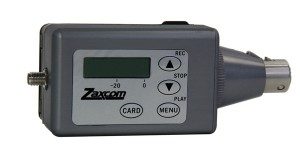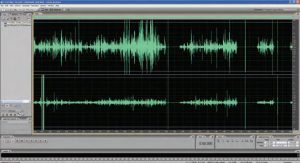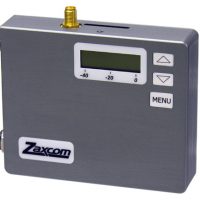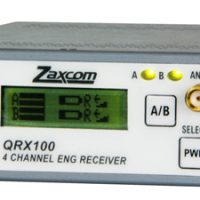Zaxcom 742 Plug-On Transmitter
As purists often do, we who have stubbornly insisted on a hardwired boom must finally admit defeat: What started as a novel party trick called “Wireless Boom” is now the rule. On production stages where a hand-held boom is used, the boom mic is much more likely to be wireless than hardwired. The old-school side of the debate was an honorable one because the hardwired mic gave us higher quality sound: far less noise, no companding, no harsh limiting… just the mic’s high fidelity signal. But as the quality of wireless systems gradually improved, more and more sound departments have come to think of the cable as an unnecessary evil. The good news is that there’s no need to sulk: We, the purists, the guardians of high standards, the stubborn holdouts, now have a way to join the winning side with dignity…

Zaxcom 742 Plug-on Transmitter
Zaxcom is well known for the high quality sound of their pure-digital wireless mic systems. While there are some competing brands with digital systems on the fringes that may eventually need to be considered, Zaxcom is currently the only significant player. In the interest of full disclosure, I’ll point out that when comparing the range-before-dropout performance of this 125mW Zaxcom digital system with a 250mW analog system from a respected competitor, the digital system’s range was about 10% less than the analog system, which is consistent with my other digital vs analog wireless comparisons over the years. But it’s important to also point out that the criteria for determining the best wireless mic system is very subjective, and a personal balance of sonic quality, range, reliability, size, and other features. The range of the Zaxcom 742 system is well within the needs of most productions, and when the goal is to have the wireless boom sound as much like a hard-wired mic as possible, Zaxcom is the clear leader. While the Zaxcom 742 plug-on transmitter can turn any mic that has a 3-pin or 5-pin XLR connector into a wireless simply by plugging it on, the most challenging use for a wireless system is the boom mic for dramatic dialog. So this review will be limited to the wireless boom.
Zaxcom has added versatility to the 742 transmitter with changeable XLR input adapters, which Zaxcom calls “cones”. There is a 3-pin cone for standard microphones (48V phantom), a 5-pin cone for stereo microphones (48V phantom), and 3-pin digital cones for both AES-3 and AES-42 microphones (10V phantom). With their new “Never Clip” technology included in the new 742 transmitter, Zaxcom pulls even further ahead in this digital one horse race.
Just a few bits about Never Clip (four bits, actually)

Because Zaxcom’s transmitters actually send a digital data stream through the air, they are able to handle two discrete channels of audio with a single transmitter and receiver. Imagine how easy it will be to get stereo effects and ambience by putting a stereo mic on one end of a boom pole and plugging in a single transmitter at the base. This, alone, makes the 742 uniquely valuable, even without considering that it is also a self-contained, high-quality, timecode, 2-channel recorder. Recording capability is in all Zaxcom transmitters, and has already been reviewed many times, so we’ll stick to just the transmitter part this time.
I’ve used wireless mics about as much as anyone over the last 35 years, in the full range of film and video production types, and am familiar with about every change and advancement made over those years. Because of that, a lot of people depend on my assessment of wireless sound equipment they choose or choose not to invest in, and I can neither afford to have them misled nor miss out. So I set out to expose the Zaxcom 742 for what it really is.
I had the 742 transmitter and QRX receiver during the same week that I had two days on the ABC series “Nashville”. (The fulltime mixer is Joe Foglia. I am the mixer on the “double-up days” and reshoots, about three days each month.). On this show I typically use a wireless system for the primary boom, and hardwire the second boom.
Before putting the 742 to work on a real production, I spent some time with it in Trew Audio’s Nashville showroom with the boom operator, Kevin Cerchiai. It is surprisingly light-weight, even with three lithium AA batteries. Kevin mentioned that it was light enough that he could use it on the mic end of the pole if needed for extra range. Granted, the mic end of the pole is not where you want the additional weight of a transmitter, but keep in mind that doing so would allow the pole’s internal coiled cable to be removed, which weighs more than the transmitter.

Kevin Cerchiai
The look and feel of the build quality is actually very nice, and shows a continued trend toward refinement on the part of Zaxcom. One point to pick on would be the battery door (but nearly all battery doors get picked on). It hinges on one end and is held closed with two strong rare-earth magnets on the other end, making for an easy one-handed operation. However, Kevin noticed that it could be accidentally jarred open a little easier than it should, so for peace of mind he secured it with tape. There seems to be room for installing another pair of small magnets, which I think would take care of the issue, and Zaxcom is looking into this possibility. We continued going through the options and settings, conducting walk-tests for range, etc., all of which seemed fine. But, as all production sound crews know, the conditions we encounter on the set can only be duplicated on the set, with real actors, and only after “Action!” has been called.
Both days with the 742 were on sound stage. The first thing we did was to walk the stage for a range test, and the Zaxcom system covered entire stage without dropouts. The first scene was a typical interior dining table set, with two actors whispering as they are prone to do these days. With levels set during rehearsal, the Zaxcom 742 showed its true colors on the first take: After a few lines of quiet dialog, one of the actors gave a laugh that was SUDDENLY VERY LOUD. During the milliseconds this was happening, my brain automatically prepared itself for the sound that would surely result: The crunch of digital overload and/or the squash of a transmitter’s brick-wall limiter. But it didn’t happen. The yell was loud, but just as clear and natural as the words before and after. In this situation of extremes – extreme low levels suddenly followed by extreme high levels – the Sennheiser MKH-8050 microphone behaved exactly like the same mic wired directly to my mixing console: No detectable additional noise, no clipping, no distortion, no limiting, and with all the clarity.
The performance of any professional audio device is somewhat dependent on the user-adjustable gain structure, which is usually a challenge for wireless mic transmitters because they are away from the person doing the mixing. But the 742, like other Zaxcom transmitters, has the ability to have its gain settings adjusted by the person at the mixer, using a Zaxcom IFB transmitter. With this system, the transmitter gain is actually adjusted as if it were the mixer’s input trim, as it should be.
Since we had only two days of production with the 742, and couldn’t risk having the transmitter batteries go flat, I have no battery-life statistics to report other than to say that we changed the three lithium AA batteries after lunch because the internal meter seemed to suggest it, and the battery change got us through the rest of the 14 hour day. Keep in mind that we turned off the transmitter whenever it was practical to do so, which could easily account for half of that time.
So, the Zaxcom 742 plug-on pure digital transmitter is nicely made, lightweight, usually has plenty of range, and accepts mono, stereo, and digital microphones, has a built-in recorder, can be controlled remotely, and has 137dB of dynamic range.
As you might expect all of these premium features come at a bit of a premium price: US$1995 for the transmitter and one cone (additional cones $200). But is it worth it? I’m sure that many will say “yes”, and put their money where their ears are. As purists often do.
9 comments
Leave a reply Delete Message
You must be logged in to post a comment.


 US
US  Canada
Canada 







I really want to test out the battery life in the real world with this and my Super CMIT. Any demos available?
Also, is there any limiter or neverclip while in AES mode?
I just finished the first season of an NBC network TV show and The mixer had taken delivery of the 742 just before we went to camera. We had found on previous jobs that using a regular zaxcom transmitter with an outboard 48 phantom pre-amp didn't work. A high-end hiss began to develop and made the signal unusable.
I can say that the 742 worked without major incident for every shooting day of a 5 month series. The never-clip feature, which to be honest I was dubious about, actually worked quite well. One of our cast members did a line in one take of a scene at his maximum volume, which was many times louder than anything he'd done before in the scene (The entire crew jumped about a foot in the air). The line delivery, which he only did once on one line of one set up, was free of distortion and was used in the pilot episode. It also held up with a variety of loud sounds, including gunfire. For mics, we used the new Sennheisser 8060 and 8050 shotgun and hyper-card.
The 125mW output was more than adequate for our purposes, and was comparable to the both the Lectro 400 series and HM plug on transmitters.
We did find that when we used the 742 with a Sanken cub-01 plant mic in a car rig there was noise on the line. This was remedied by reducing the output to 50mW.
I usually use the 742 on the end of the boom near the mic, which is just a personal preference. One of the complaints I did have with it is that unlike the Lectro plug ons, the switchcraft connector Zaxcom uses has too much play in it. I wasn't comfortable leaving it on the boom attached to the mount by only the connector. I wrapped several rubber bands around it to keep it snug to the mount (indoors we use a Cinela Orix mount with a wider adapter on the base to move the XLR conector further away from the pole, and outside an Ambient connector mounted on a Rycote). This worked, but looked a little ghetto.
As for battery life, We used Ansmann rechargeable AA batteries. I will say it is a little thirsty and to be safe I would change batts every 3 hours on average. We did have an issue when we shot on a beach in January in Toronto in -20c weather. The rechargeable batts would die after about 15 minutes. We switched to Lithium batteries and that seemed to work. Although that was more the perils of NMH batts outdoors than the 742.
Any chance this unit would work with a Sennheiser 416t?
We use the 742 with Sennheisser 8060's, 50's, and 40's with no problems. A 416 should work fine.
Recently, we started using the stereo AES cone on the 742 with a Schoeps Super CMIT mic. This allows the transmission of both the processed and unprocessed signal on one digital channel with true diversity reception an no breakout boxes needed. After some initial snags, it worked perfectly.
Reading over the previous comment I now notice you said a 416t. If you meant a T-power microphone, you would need an outboard pre to run it.
Hi,
This is "Rafique" A Sound Mixer based in Mumnbai, India.
I often Mix Production dialogue/Ambiance and come across many daily issues wireless/wired Mikes.
trewaudio has been a friend in need always
Thankyou guys
Rafique
I just wrapped a feature with the 742 and am so far quite happy with it.
Some comments/impressions/questions....
My boom op and I found that it got quite hot to the touch, even when transmitting at the lowest mW setting. Operating temperature did not seem to vary with changes in transmission power.
Some boom operators will prefer the TX strapped to the end of the pole while others will prefer it at their waists. On the waist is fine, but once strapped to the pole it will be difficult to quickly change batteries and turn "on/off".
A difficult design issue to get over is that in order for the unit to be turned "on/off" it will have to be removed from the pole and then opened up.
I'm not such a fan of this buried switch.
Should a right angle antenna be used if at the end of a pole?
Battery life on three lithium AA's got us to lunch as Glen stated in his review.
I'm very happy with this battery consumption.
We found that the battery meters on both the 742 and on the new QRX200 were not very accurate. Fresh batteries would show full upon turn on and then instantly drop to 3/4, 1/2 or even lower.
Battery life was fine, just unreliable battery meters.
Yes, everything is set to Lithium. It only shows full when set to "NiMH", which I'm sure isn't accurate.
Having used the 992 prior to using the 742, my TX gain settings were wildly different. I found that on the 992 I'd set my gain at around 7 or 8 for normal dialogue using the Sanken CS3e.
The 992 is a very sensitive transmitter and I'm not a fan of using the built in limiter.
First thing I noticed with the 742 was that it was not so sensitive. For normal dialogue with the CS3e I'd set the 742 to anywhere between 25 and 30. I would confirm that my gain was set correctly by watching the small volume meter on the QRX200 during rehearsals. The green/blue/red side lights on the QRX200 also made it easy to quickly see if audio was too hot at the TX or not. It rarely was.
If anyone has any advice as to where the 742 should be set for normal dialogue, I'll take it.
My main microphones are the Sanken CS3e, Schoeps CMC6/MK41 and the Sennheiser 8050. As the Sanken is a much more sensitive mic I tend to lower my TX settings by 6 to 10 dB when using it. But again, those 6 to 10 "clicks" on the 742 are much different than 6 to 10 "clicks" on the 992 or Lectrosonics HM/SM transmitters.
Again, any advice/field experience here would be greatly appreciated.
Thanks!
Dave
On the show I've been doing, we set the gain on the 742 at 25db. We have been using Sennheisser 8060's and 8050's. I agree that the location of the battery lid and power switch are not great for mounting the unit on the pole. I have mine attached at the XLR connector rather than on the shaft of the pole, so it's easier to pop the whole mic and mount assembly off the pole and change batteries. The display meter isn't very accurate for battery life, but if you press the down arrow button the voltage is useful. Normally we use NMH rechargeable batteries and find we get about 3 hours out of them.
The battery meter often starts at max and drops quickly with lithiums. I suspect this is because it takes time to adjust for the load on the batteries. When we use the 742 in stereo digital mode with the Super CMIT mic, you can see the level drop after you plug the mic in. If you unplug the mic, the load is reduced and the meter goes up. Either way, the meter spends most of its useful life between 50% and 25%.
We always use the straigh antennas with the 742 on the boom or in a pouch, and it seems to work fine.
The unit does get warm, but that seems to be normal.